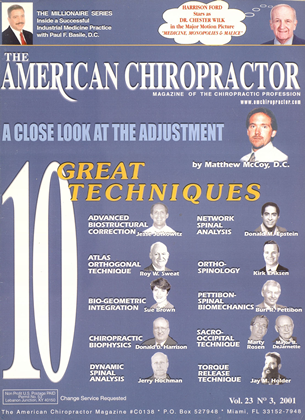The second branch of philosophy, epistemolo-gy. explores the theory of knowledge. It asks the question. "How do I know?" As chiropractors, we must ask ourselves what our rules of evidence are. Randomized controlled clinical trials? Empirical data? Outcome measures? Quality of life surveys? Tradition? Intuition? Logic and deduction? We cannot develop a useful episte-mology until we first start with a metaphysical view; metaphysics being defined as one's view of the nature of reality. Many chiropractors, myself included, start metaphysically, with two axioms: 1) The living body is innately a self-healing, self-regulating organism, and 2) The nervous system is the master system and controller of that body. For most, if not all. this is self-evident. The first epistemological conclusion drawn from this is through deduction. If the body is self-healing and self-remilatina. and if the ner- vous system is the master system and controller of the body, then it stands to reason that, if there is any interference with nerve function, there must. then, necessarily be interference with the body's ability to heal and regulate. The question is. where does one go from here? There is the concept of innate intelligence. There is the concept of vertebral subluxution. There is the concept of the adjustment. Then there is the concept of everyday practice. If we define vertebral subluxa-tion as nerve disturbance related to altered spinal mechanics, which disturbs the bodies ability to heal, regulate, perceive and adapt to its environment, three corollary issues arise: 1) What causes subluxations. 2) How do you know if an individual is sub- luxated. 3) How do you know if your services are having a beneficial effect relative to these vertebral subluxations. Question one, the causes of sublux-ation. we will leave for another time. In this communication, we will briefly explore two and three. How do you know if vour patient (practice member) is subluxated? What are your rules? Have you. somehow, operationally defined vertebral sublux-ation: and. if you have, have you tested these chosen definitions for congruen-cy with your metaphysical views and epistcmological rules? Are your approaches to these issues based on reason or mysticism? In my opinion, chiropractic is not a religion and. therefore, should not be based on mysticism or dogma. It is the power of reason, matched with the evidence of the senses and contemporary technology that shapes my chiropractic conclusions. To me, the concept of vertebral subluxation is quite tangible. It does not require my belief or faith, but. rather, is a byproduct of rational thought processes. Understanding the body as a three-dimensional (maybe four-, with time), non-linear, chaotic, biological system, is a key metaphysical view (vitalism), from which you can set up epistemological directions. If nou start with the false metaphvsical view that the body is a one-dimensional, linear, machine (mechanism), you may head down what is, seemingly, a rational epistemological path; but. it would be based on a Hawed premise and. therefore, its conclusions would be flawed. The more you can improve the quality of the relationship between consciousness and reality, the better your conclusions and effectiveness. There is no unifying theory in science that explains everything. This is especially true of the biological sciences. No one has all the answers. Beware of people who tell you they do. Especially, beware of hypocrites who tell you that they are scientific chiropractors, because they limit their practices to pain-based treatment: but. somehow, you are unscientific, because your practice is about sublux-ation correction. I will challenge their premises any day of the week, and they would lose this debate. It still can't be fully explained how the brain and nervous system work. Consciousness, to a large extent, is still a mystery. There is nothing that explains it all as a closed system, so no one has all the answers. It all boils down to what rules you play by: and can you explain your use of these rules without faith or dogma? For my mind, the evidence that vertebral subluxations exist is compelling. There are deductions that predict their effects. There are randomized controlled clinical trials that show these predicted effects. There are outcome measures that quantify improvement in nerve function after adjustments. There are decades of anecdotal data demonstrating what happens in the real world when these principles are applied. Only a fool with a dishonest political agenda could ignore this. How does this enter the real world of your practice? How do you know if your patient is subluxated? How do you know if what you are doing is having any effect in the context of sublux-ation correction? If you want to practice congruently. in a rational way. you will have to have contemporary technology that will give you objective measures of the manifestation of ver-Continued on Page 51 ...from Page 41 tebral subluxation. The focus of vertebral subluxation is its physiological impact via nerve disturbance. How are you characterizing this on an individual, patient-by-patient basis? In conclusion, I would recommend an exercise for you that could be revealing. Tomorrow, in your practice, look at the procedures that you perform and the recommendations that you make. Ask yourself what they are based on. What are their implications? Do they relate to vertebral subluxation? If not, it is time to start making some changes. Practice chiropractic with reason. The world does not need another religion. Patrick Gentempo, Jr., D.C., Co-Founder and CEO of the Chiropractic Leadership Alliance in Maxwood, NJ, is a 1983 graduate of Life College. An internationally renowned chiropractor, lecturer, and consultant, he has helped thousands of chiropractors achieve success and balance in their lives. Dr. Gentempo is also co-creator of the practice and life-changing Total Solution program. For information about CLA seminars, products, and senices. call 800-285-2001. o
 View Full Issue
View Full Issue






